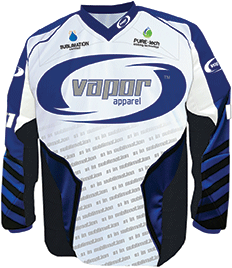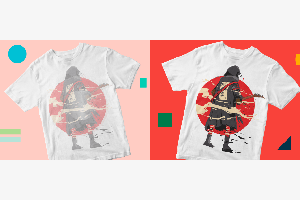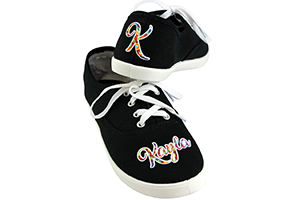August 1, 2013
Sublimation is growing in many different parts of the printing industry. From signage to building materials, sublimation is all over the place in its applications. What other print technology can be used to make items ranging from skateboards and cycling jerseys to banner flags and cell phone covers?
But most of us are printers in the apparel space; that is our focus. So when the topic of sublimation arises, there are a couple of ways you can go. Most traditional screen printers are interested in allover print sublimation (AOPS) but there is an entirely different side of sublimated apparel that you should know about.
For people focused on the athletic side of the apparel market, cut-and-sew sublimation has become a platform they carefully are considering. It is not for the faint of heart. Entering the cut-and-sew business is no small task and there are a lot of factors to consider:
1. Access to cutting and sewing resources
2. Sublimation print platform
3. Heat transfer machine availability
4. Customer demand and markets to enter
5. File and printing workflow
6. Artwork systems and options for your clients
7. Front-end customer service/web interfaces
8. Templates and patterns
If you are willing to build solutions for factors 1-8 and you have the proper marketplace opportunity, cut-and-sew sublimation can change the nature of your business and separate you from your competitors. Here are the details to consider for each of these eight important factors.
1. Finding the proper cut-and-sew resources is no small task.
Depending on your circumstances, it can be the hardest part of the solution to find. Forty years ago, there still was a significant amount of cut-and-sew resources in certain regions of the country. Today, they are harder to find, causing many sublimators to bring the process in house or keep their current resources to themselves.
The Carolinas and other parts of the South do still have pockets of sewing resources. Los Angeles and New York also have ample amounts of these resources. But outside of these areas, access to the right types of sewers and equipment depends on your unique circumstances. Bringing this expertise in-house is ideal for accountability and ensuring it is there when you need it.
2. Getting yourself outfitted with the right sublimation print platform can be the easiest part of getting set up.
If you do not vet your options and make sure you are getting the right platform, you can find yourself spending up to $15,000 out of pocket with the wrong equipment. The best printer will work in concert with your transfer press.
The majority of people doing cut-and-sew sublimation use a rotary heat press. Most of these can work with the output of a 64-inch-wide, large-format sublimation printer. Making sure your printer and transfer press widths work together is critical. You do not want to buy a 44-inch-wide printer to save a few dollars, then find yourself unable to print 3XL, 4XL and, yes, 5XL garments. Cut-and-sew operators often are called upon to make these larger sizes for clients, and printer-width limitations can cause you stress if not planned out.
Note: Mimaki, Roland and Epson all make printers suitable for this part of your system. You also need an RIP software application to ensure correct color (ErgoSoft and Wasatch both compete in this arena).
3. A heat transfer machine is the largest equipment investment you will make to enter the cut-and-sew arena.
It is a critical aspect of your operation. There are two available options in the marketplace, each of which has benefits that the other lacks.
First is the flatbed press, which will cost less on your initial investment. This press also is suitable for AOPS. But for cut-and-sew sublimation, it requires you to cut your fabric to the size of the platen each time you press a garment. This increases both labor costs over time and the risk for transfer errors. But in the short term, it can do more things for you at a lower cost.
The second option is the rotary heat press, which will cost you more on your initial investment. This press allows you to print an entire roll of paper and fabric in a continuous process, which reduces labor costs over time. It is the better long-term solution for cut-and-sew profitability.
4. Customer demand is your most vital need.
Without a sales opportunity, this investment does not make sense. You must have the right type of customers — both actual and prospective — to make cut-and-sew sublimation work the right way.
Before you decide this is for you, it may be helpful, if not practical, to consider outsourcing it to confirm you have the demand for it. Traditional demand is in the sports and team markets. Many players, from participants in basketball to ultimate Frisbee, invest in customized uniforms. All types of sports are good, but some are growing rapidly. Cycling also is a great market for cut-and-sew sublimation. So are extreme sports and the traditional angler markets. Make sure you confirm demand before committing the resources to move forward.
5. Seamless file/print workflow is a necessity.
Automation is critical for United States manufacturers. Cut-and-sew decorating is no exception. You need good printer workflow coming out of the art department and seamlessly into print production. Creating uniform formats for art and paperwork are mandatory if you want to be profitable. Having good color curves and vibrant output make a big difference in customer satisfaction. Harnessing the power of “variable data applications” will reduce art time and allow your business to scale. You need to find this expertise in the market and secure a relationship with it. Your consumables and equipment vendors often can deliver some of this expertise. Confidence in your print flow, and documentation of it, are simply musts.
6. Artwork systems, and garment and design options will be important for non-professional customers.
Most customers are not going to have the artwork you need to move them into production. They will rely on you to have a standard garment that meets their needs. They most likely will be looking for a background pattern, a predefined design that can be edited to their specifications. They need something to which they can add sponsor logos, names and numbers. If you do not have these different garments and design options, you will stumble with most non-professional clients.
7. Don’t forget front-end customer service and Internet interfaces.
It is worth mentioning this part specifically when considering adding a cut-and-sew operation. If you have the right type of digital workflow in printing, you should have a good online workflow for taking orders and automating the accounting element as well. You can lose a lot of time and profit by not automating this. It involves a significant investment and can potentially exceed your equipment investment, depending on your circumstances.
8. Templates and patterns will be in demand.
Two things that people constantly are seeking at the beginning of cut-and-sew operations are templates and garment patterns. Most current operators will not give you their patterns. Your options include working with a pattern maker or bringing one in house. There are many different types of patterns and some of the more sophisticated sewers will require a specific format. Resources exist for buying pre-made pattern sets, but they run the gamut in quality and cost.
The bottom line is that a cut-and-sew operation is not for people who want to play in this space. It is for serious printers who want to grow their businesses in a sophisticated way. If you approach your business with a level of seriousness and focus, you can profit and diversify by adding this process. Customer identification and product demand validation are essential. Make sure you have access to the expertise and experience you need to do it right the first time.
Chris Bernat is chief revenue officer at Vapor Apparel. He is a current board member of SGIA, and he speaks and writes on sublimation and mass customization for SGIA, ISS, FESPA and Dig South. For more information or to comment on this article, e-mail Chris at chris@vaporapparel.com.
Why Do We Call it Cut and Sew?
“Cut and sew” has been an industry term for decades. Within the sublimation space, it is defined as printing your transfer paper and then transferring the image onto fabric prior to the cutting and sewing of the completed garment. Outside of sublimation, it is the part of the traditional apparel manufacturing process where you cut fabric and sew it into a completed garment.
April 12, 2023 | Sublimation
As you work toward becoming an experienced dye-sublimation apparel, general merch or customized promotional items decorator, you may come across one or more obstacles, like your transfers coming out blurry, dull or faded.
FULL STORY
June 1, 2022 | Sublimation
How many times have you wished that you could sublimate a product that wasn’t polymer-based or polymer-coated.
FULL STORY
October 8, 2021 | Sublimation
I think the philosophy of lagniappe should be taught at every school and practiced by every business. A French word meaning “unexpected extra gift,” lagniappe often is used in Louisiana. In fact, sublimation decoration is a fantastic example of this.
FULL STORY




